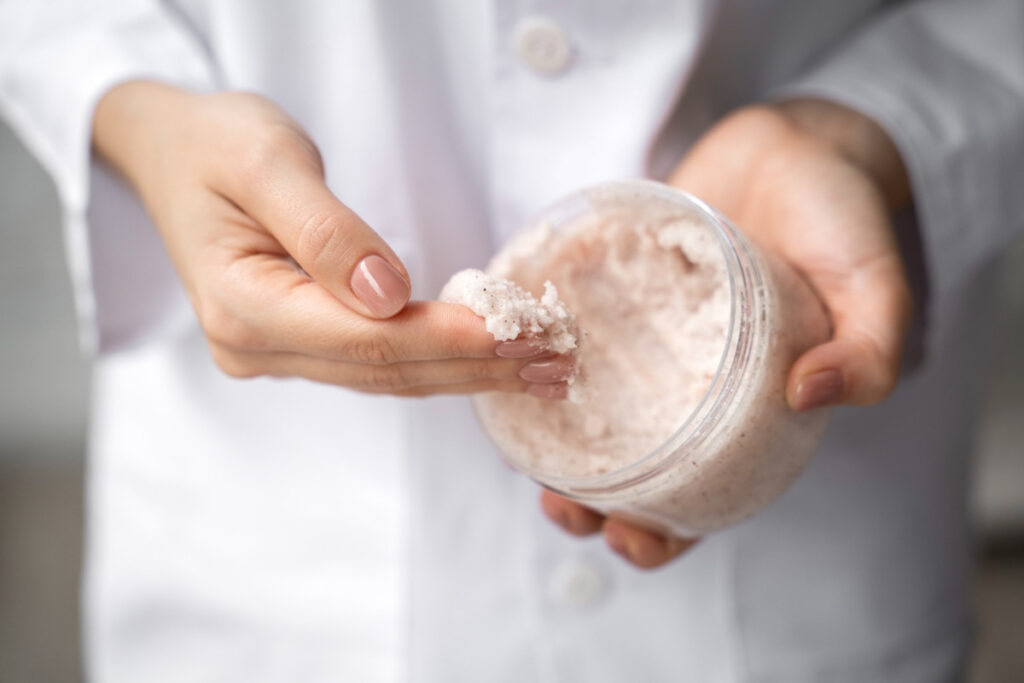Sodium hydroxide in skin care, also known as lye or caustic soda, is commonly used in the formulation of various skincare products.
Despite its harsh reputation, sodium hydroxide plays a critical role in creating effective and safe skincare formulations when used in controlled quantities.
In this article, we will explore how sodium hydroxide functions in skin care, its benefits, potential risks, and how to choose products that incorporate it.
What is Sodium Hydroxide in Skin Care?
Sodium hydroxide is an inorganic compound with the chemical formula NaOH.
It is highly alkaline and often used in skincare products to adjust pH levels, ensuring that products perform optimally on the skin.
In its pure form, sodium hydroxide is a caustic substance, but in small, diluted amounts, it is safe and effective in skincare formulations.
Its primary role in skincare is as a pH adjuster, helping to balance the acidity or alkalinity of a product.
This adjustment ensures that the product maintains its effectiveness without irritating the skin.
How Sodium Hydroxide Works in Skin Care Products
Sodium hydroxide works by altering the pH of a product, which in turn can affect the stability and effectiveness of the active ingredients in the formula.
Most skincare products need to be formulated at a specific pH to prevent irritation and enhance their efficacy.
For example, alpha hydroxy acids (AHAs) work best in an acidic environment, while certain preservatives require a more alkaline pH.
By carefully adjusting the pH using sodium hydroxide, formulators can create products that deliver maximum benefits without compromising safety.
This is especially important in products like cleansers, exfoliants, and toners, where pH balance is crucial for both effectiveness and skin tolerance.
The Benefits of Sodium Hydroxide in Skin Care
One of the key benefits of sodium hydroxide is its ability to stabilize the formulation of skincare products.
Stabilization is important because it ensures that active ingredients remain effective throughout the product’s shelf life.
It also helps to create the ideal pH environment that promotes the absorption of other beneficial ingredients, such as vitamin C, retinol, or hyaluronic acid.
Sodium hydroxide can also enhance the penetration of exfoliating agents, improving their ability to remove dead skin cells and reveal smoother, more radiant skin.
Additionally, sodium hydroxide aids in emulsifying formulations, ensuring that oils and water-based ingredients blend together properly for a more uniform application.
The Risks and Side Effects of Sodium Hydroxide in Skin Care
Despite its benefits, sodium hydroxide can cause irritation if used in excessive amounts or in products not formulated with the proper pH balance.
Overuse of products containing sodium hydroxide can strip the skin of its natural oils, leading to dryness, redness, and increased sensitivity.
Those with sensitive skin or conditions like eczema and rosacea may be particularly susceptible to irritation caused by sodium hydroxide.
It is also important to note that higher concentrations of sodium hydroxide are typically only found in more intensive treatments, such as chemical peels, and should be used with caution.
When using products containing sodium hydroxide, it is essential to follow the instructions and perform patch tests to ensure they are suitable for your skin type.
Sodium Hydroxide vs. Other Common pH Adjusters
Sodium hydroxide is just one of several pH adjusters used in skincare formulations.
Other common pH adjusters include citric acid, lactic acid, and potassium hydroxide, each with its unique properties.
Citric acid, for example, is an organic acid commonly used in cosmetics to lower pH, while potassium hydroxide is a milder alkaline substance that is less harsh than sodium hydroxide.
However, sodium hydroxide is often preferred in certain formulations due to its efficiency in adjusting pH quickly and maintaining the stability of the product.
The choice of pH adjuster depends on the overall formulation, the desired effect, and the specific ingredients being used.
Is Sodium Hydroxide Safe for All Skin Types?
Sodium hydroxide can be safe for most skin types when used in low concentrations, but it may not be ideal for those with particularly sensitive skin.
For oily skin, sodium hydroxide can help balance the skin’s natural oils and reduce the risk of acne by preventing the overgrowth of bacteria.
For dry skin, sodium hydroxide should be used in moderation to avoid stripping the skin of moisture.
Sensitive skin types, including those with conditions like rosacea or eczema, should be cautious with products containing sodium hydroxide and opt for formulations specifically designed for delicate skin.
If you are unsure about how sodium hydroxide will react with your skin, consult a dermatologist before introducing products with this ingredient into your routine.
How Sodium Hydroxide Enhances Product Effectiveness
In skincare, the role of sodium hydroxide extends beyond pH adjustment.
By ensuring that the pH is balanced, sodium hydroxide also enhances the overall effectiveness of other active ingredients in the product.
For example, sodium hydroxide can help exfoliating acids penetrate deeper into the skin, allowing them to exfoliate more efficiently and reveal fresher, healthier skin.
It also plays a role in enhancing the absorption of antioxidants and hydrating ingredients, ensuring they can work more effectively on the skin’s surface.
As a stabilizing agent, sodium hydroxide ensures that these active ingredients remain potent throughout the product’s shelf life.
Alternatives to Sodium Hydroxide in Skin Care
While sodium hydroxide is widely used in skincare, some individuals may prefer to avoid it due to skin sensitivities or personal preferences.
Alternative pH adjusters such as citric acid or potassium hydroxide offer milder options for adjusting pH without the potential for irritation.
Additionally, some skincare products are formulated without any pH adjusters, relying on the natural pH of the skin to maintain balance.
If you are looking for a more natural skincare routine, look for products that use plant-based acids like lemon or apple cider vinegar, which can provide mild exfoliation and pH balancing without the harsh effects of sodium hydroxide.
How to Choose Skin Care Products with Sodium Hydroxide
When choosing skincare products that contain sodium hydroxide, it’s important to pay attention to the overall formulation.
Look for products that list sodium hydroxide as one of the last ingredients, which typically indicates a lower concentration.
It’s also essential to choose products from reputable brands that formulate with safe concentrations of sodium hydroxide and include other beneficial ingredients like soothing agents or moisturizers.
If you have sensitive skin, choose products specifically designed for your skin type to minimize the risk of irritation.
Sodium hydroxide, when used correctly, is a highly effective ingredient in skincare that helps balance pH, enhance absorption, and stabilize formulations.
If you’re looking to improve your skin’s appearance and rejuvenation, look for products that provide a balanced, gentle formula with active ingredients designed for your skin type.
Consider trying products like Illuderma, a natural serum that nourishes, hydrates, and rejuvenates the skin, helping to smooth fine lines and enhance radiance.
Visit the official Illuderma website to explore how it can complement your skincare routine.









